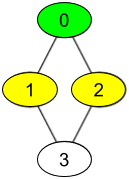There are n people, each person has a unique id between 0
and n-1. Given the arrays watchedVideos and
friends, where watchedVideos[i] and friends[i]
contain the list of watched videos and the list of friends respectively for the person
with id = i.
Level 1 of videos are all watched videos by your friends, level
2 of videos are all watched videos by the friends of your friends
and so on. In general, the level k of videos are all watched
videos by people with the shortest
path equal to k with you. Given
your id and the level of videos, return the list of
videos ordered by their frequencies (increasing). For videos with the same frequency
order them alphabetically from least to greatest.
Example 1:

Input: watchedVideos = [["A","B"],["C"],["B","C"],["D"]], friends = [[1,2],[0,3],[0,3],[1,2]], id = 0, level = 1 Output: ["B","C"] Explanation: You have id = 0 (green color in the figure) and your friends are (yellow color in the figure): Person with id = 1 -> watchedVideos = ["C"] Person with id = 2 -> watchedVideos = ["B","C"] The frequencies of watchedVideos by your friends are: B -> 1 C -> 2
Example 2:

Input: watchedVideos = [["A","B"],["C"],["B","C"],["D"]], friends = [[1,2],[0,3],[0,3],[1,2]], id = 0, level = 2 Output: ["D"] Explanation: You have id = 0 (green color in the figure) and the only friend of your friends is the person with id = 3 (yellow color in the figure).
Constraints:
n == watchedVideos.length == friends.length2 <= n <= 1001 <= watchedVideos[i].length <= 1001 <= watchedVideos[i][j].length <= 80 <= friends[i].length < n0 <= friends[i][j] < n0 <= id < n1 <= level < n- if
friends[i]containsj, thenfriends[j]containsi